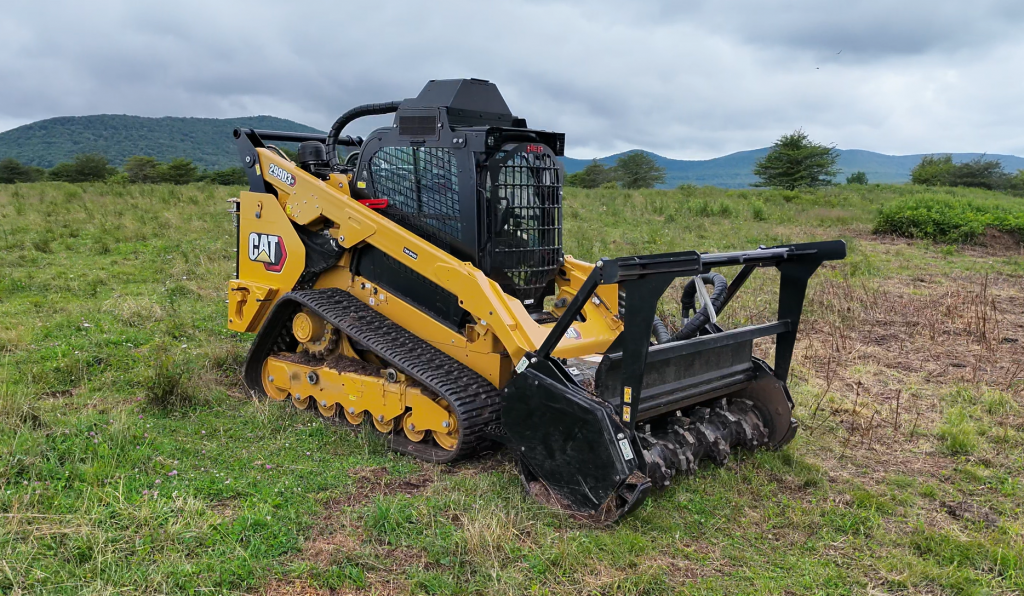New Equipment Improves Wildlife Habitat in the Monongahela National Forest
In the mountains of West Virginia, a unique piece of equipment is enhancing wildlife habitat and increasing overall forest health, thanks to a partnership between the West Virginia NWTF State Chapter, the USDA Forest Service and the West Virginia Division of Natural Resources. By providing critical funding, the West Virginia NWTF State Chapter was able to outfit an agency-owned land management skid steer with specialized safety equipment required by the agencies for operation. The potential of this machine was previously unrealized because of budget restraints — until now.
The new machine belongs to the Monongahela National Forest and is currently operated by the WVDNR to enhance wildlife habitat on the more than 919,000-acre national forest. By combining resources and expertise, partners are demonstrating how strong partnerships multiply conservation impact.
“The machine has been used to meet management objectives on the forest but not used to its fullest potential due to the lack of specialized add-on safety equipment,” said Cully McCurdy, NWTF district biologist for West Virginia, Virginia and North Carolina. “The NWTF was approached by the Forest Service to assist with the purchase and installation of the required safety equipment, and we readily agreed. Within a couple of weeks, the machine was working daily on high-elevation grazing allotments, creating habitat and diversity in areas with mid-successional growth that needed to be opened and made suitable for planting of wildlife-friendly seed mixes.”
The safety equipment installed on the machine included a rear door guard kit which is a tubular guarding structure delivering protection to the rear of the machine in demanding operations like demolition and land management. It includes a swing-out guard for engine compartment access and mounting of a rear camera. The second safety upgrade was a skeleton steel front door guard to cover the factory polycarbonate door to add protection from debris impact.

Forest and land managers have increasingly turned to mastication — a mechanical process that grinds or shreds underbrush, small trees and unwanted vegetation into mulch — because of the wide-ranging benefits the management practice provides.
Mastication encourages healthy forest growth and improves wildlife habitat by opening the forest canopy. More sunlight can reach the forest floor, which encourages the growth of native grasses and forbs. In some instances, removing shrubby species also allows wildlife to better utilize diverse layers of vegetation that would have previously blocked wildlife movement and choked out the plants many species depend on for food.
In addition, it reduces high-intensity wildfire risk by removing excess underbrush and dense stands of small trees that create ladder fuels, vegetation that allows fire to climb from the forest floor into the canopy. Mastication also helps with erosion control and soil health.
For the WVDNR and the Forest Service, the work is already showing results.
“Shrub layers and mid-story growth are valuable habitats,” McCurdy said. “However, sometimes you can have too much of a good thing. The use of specialized equipment like a forestry mulcher helps us achieve a balance on the landscape.”
In the first 2 weeks of operation, 40 acres have been impacted by the machine with plans to operate well into the fall. The results from the treatment will reclaim the high elevation openings on the forest and return the area to herbaceous habitat more in line with the management objective of the Monongahela National Forest.
About the National Wild Turkey Federation
Since 1973, the National Wild Turkey Federation has invested over half a billion dollars into wildlife conservation and has positively impacted over 24 million acres of critical wildlife habitat. The NWTF has also invested over $10 million into wild turkey research to guide the management of the wild turkey population and to ensure sustainable populations into perpetuity. The organization continues to deliver its mission by working across boundaries on a landscape scale through its Four Shared Values: clean and abundant water, healthy forests and wildlife habitat, resilient communities, and robust recreational opportunities. With the help of its dedicated members, partners and staff, the NWTF continues its work to provide Healthy Habitats. and Healthy Harvests. for future generations.
